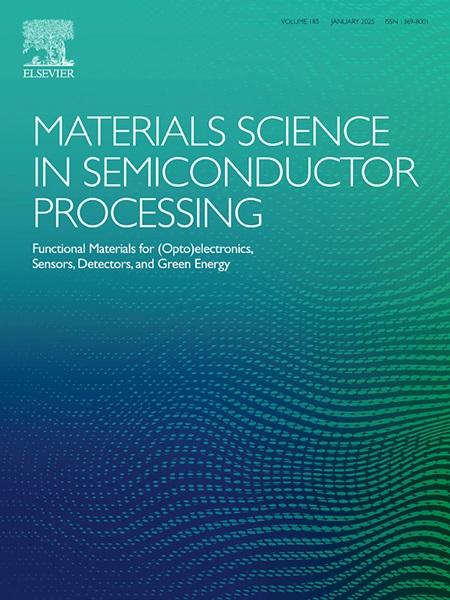通过SiC共溅射和氧空位控制提高p型SnO TFTs的性能
IF 4.2
3区 工程技术
Q2 ENGINEERING, ELECTRICAL & ELECTRONIC
引用次数: 0
摘要
高性能p型氧化物半导体的实现是实现基于透明电子的互补金属氧化物半导体(CMOS)技术的关键里程碑。然而,Sn2+氧化态的热力学不稳定性和snoo薄膜中氧空位的普遍存在严重阻碍了其电子性能。在这项研究中,我们提出了一种新的策略,通过与碳化硅(SiC)共溅射,然后进行高真空沉积后退火(HVPDA)来提高p型SnO薄膜晶体管(TFTs)的结构和电学性能。利用Si-O和C-O的高键解离能,有效抑制氧空位,从而稳定了亚稳Sn2+态,促进了相纯SnO的形成。通过x射线衍射和拉曼光谱的结构分析证实了SnO的选择性结晶,没有出现SnO2或金属Sn相,特别是在300°C的优化退火温度下。霍尔效应测量表明,随着SiC浓度的增加,载流子密度明显降低,空穴迁移率提高(高达2.41 cm2/V·s)。制备的背门控tft表现出稳健的p型传导,峰值场效应迁移率达到1.5 cm2/V·s,离子/IOFF比超过3.7 × 104,同时亚阈值行为增强。这些发现强调了SiC共溅射和HVPDA在定制sno基半导体的微观结构和缺陷方面的协同作用,为下一代高性能、透明、p型氧化物tft建立了一条有希望的途径。本文章由计算机程序翻译,如有差异,请以英文原文为准。
Enhancing the performance in p-type SnO TFTs through SiC co-sputtering and oxygen vacancy control
The realization of high-performance p-type oxide semiconductors is a pivotal milestone in achieving complementary metal-oxide-semiconductor (CMOS) technology based on transparent electronics. However, the thermodynamic instability of the Sn2+ oxidation state and the prevalence of oxygen vacancies in SnO thin films critically hinder their electronic performance. In this study, we present a novel strategy to enhance the structural and electrical properties of p-type SnO thin-film transistors (TFTs) through co-sputtering with silicon carbide (SiC), followed by high-vacuum post-deposition annealing (HVPDA). By leveraging the high bond dissociation energies of Si–O and C–O, oxygen vacancies were effectively suppressed, thereby stabilizing the metastable Sn2+ state and promoting the formation of phase-pure SnO. Structural analyses via X-ray diffraction and Raman spectroscopy confirmed the selective crystallization of SnO without the emergence of SnO2 or metallic Sn phases, particularly at an optimized annealing temperature of 300 °C. Hall effect measurements demonstrated a clear trend of reduced carrier density and enhanced hole mobility (up to 2.41 cm2/V·s) with increasing SiC concentration. The fabricated back-gated TFTs showed robust p-type conduction, achieving a peak field-effect mobility of 1.5 cm2/V·s, and ION/IOFF ratio exceeding 3.7 × 104, alongside enhanced subthreshold behavior. These findings highlight the synergistic role of SiC co-sputtering and HVPDA in tailoring the microstructure and defect landscape of SnO-based semiconductors, establishing a promising pathway for the next generation of high-performance, transparent, p-type oxide TFTs.
求助全文
通过发布文献求助,成功后即可免费获取论文全文。
去求助
来源期刊

Materials Science in Semiconductor Processing
工程技术-材料科学:综合
CiteScore
8.00
自引率
4.90%
发文量
780
审稿时长
42 days
期刊介绍:
Materials Science in Semiconductor Processing provides a unique forum for the discussion of novel processing, applications and theoretical studies of functional materials and devices for (opto)electronics, sensors, detectors, biotechnology and green energy.
Each issue will aim to provide a snapshot of current insights, new achievements, breakthroughs and future trends in such diverse fields as microelectronics, energy conversion and storage, communications, biotechnology, (photo)catalysis, nano- and thin-film technology, hybrid and composite materials, chemical processing, vapor-phase deposition, device fabrication, and modelling, which are the backbone of advanced semiconductor processing and applications.
Coverage will include: advanced lithography for submicron devices; etching and related topics; ion implantation; damage evolution and related issues; plasma and thermal CVD; rapid thermal processing; advanced metallization and interconnect schemes; thin dielectric layers, oxidation; sol-gel processing; chemical bath and (electro)chemical deposition; compound semiconductor processing; new non-oxide materials and their applications; (macro)molecular and hybrid materials; molecular dynamics, ab-initio methods, Monte Carlo, etc.; new materials and processes for discrete and integrated circuits; magnetic materials and spintronics; heterostructures and quantum devices; engineering of the electrical and optical properties of semiconductors; crystal growth mechanisms; reliability, defect density, intrinsic impurities and defects.
 求助内容:
求助内容: 应助结果提醒方式:
应助结果提醒方式:


